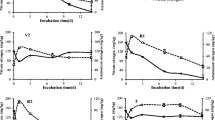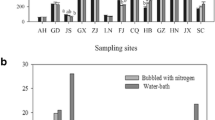Abstract
A 15N dilution experiment was carried out to investigate effects of cultivation on the gross N transformation rate in coastal wetland zone. Microbial community composition was estimated by phospholipid fatty acid (PLFA) analysis and abundance of soil ammonia-oxidizing bacteria (AOB) was quantified by real-time polymerase chain reaction (PCR). Soil salinity decreased significantly, while total N increased after coastal wetland was cultivated. Microbial biomass (total PLFA), bacterial biomass, fungal biomass, and actinomycete biomass of the native coastal wetland soils were significantly (p < 0.05) lower than those of the cultivated soils whereas AOB population size also significantly increased after coastal wetland cultivation. Multiple regression analysis showed that total PLFA biomass and soil total N (TN) explained 97% of the variation of gross N mineralization rate in the studied soils (gross mineralization rate = 0.179 total PLFA biomass + 5.828TN − 2.505, n = 16, p < 0.01). Gross nitrification rate increased by increasing the soil AOB population size and gross mineralization rate (M) (gross nitrification rate = 3.39AOB + 0.18 M − 0.075, R 2 = 0.98, n = 16, p < 0.01). Management of salt discharge and mineral N fertilization during the cultivation of wetland soils might have changed composition of soil microflora and AOB population size, thus influencing mineralization and nitrification. Probably, the cultivation of coastal wetland soils increased the risk of N losses from soil through nitrate leaching and gas emission (e.g., N2O and NO).

Similar content being viewed by others
References
Barraclough D, Puri G (1995) The use of 15 N pool dilution and enrichment to separate the heterotrophic and autotrophic pathways of nitrification. Soil Biol Biochem 27:17–22
Bligh EG, Dyer WJ (1959) A rapid method of total lipid extraction and purification. Can J Biochem Physiol 37:911–917
Booth MS, Stark JM, Rastetter EB (2005) Controls on nitrogen cycling in terrestrial ecosystems: a synthetic analysis of literature data. Ecol Monogr 75:139–157
Chu HY, Fujii T, Morimoto S, Lin XG, Yagi K (2008) Population size and specific nitrification potential of soil ammonia-oxidizing bacteria under long-term fertilizer management. Soil Biol Biochem 40:1960–1963
Ding W, Yagi K, Cai Z, Han F (2010) Impact of long-term application of fertilizers on N2O and NO production potential in an intensively cultivated sandy loam soil. Water Air Soil Pollut. doi:10.1007/s11270-010-0328-x
Frostegård A, Bååth E, Tunlid A (1993) Shifts in the structure of soil microbial communities in limed forests as revealed by phospholipid fatty acid analysis. Soil Biol Biochem 25:723–730
Harris JA (2003) Measurements of the soil microbial community for estimating the success of restoration. Eur J Soil Sci 54:801–808
Hart SC, Stark JM, Davidson EA, Firestone MK (1994) Nitrogen mineralization, immobilization, and nitrification. In: Hart SC, Stark JM, Davidson EA, Firestone MK (eds) Methods of soil analysis part 2: microbiological and biochemical properties. Soil Science Society of American, Madison, WI, pp 985–1018
Hedrick DB, Peacock A, Stephan JR, Macnaughton SJ, Brüggemann J, White DC (2000) Measuring microbial community diversity using polar lipid fatty acid and denaturing gradient gel electrophoresis data. J Microbiol Meth 41:235–248
Hermansson A, Lindgren PE (2001) Quantification of ammonia oxidizing bacteria in arable soil by real-time PCR. Appl Environ Microbiol 67:972–976
Killham K (1986) Heterotrophic nitrification. In: Prosser JI (ed) Nitrification. IRL Press, Oxford, UK, pp 117–126
Kirkham D, Bartholomew WV (1954) Equations for following nutrient transformations in soil, utilizing tracer data. Soil Sci Soc Am Pro 18:33–34
Kowalchuk GA, Stephen JR (2001) Ammonia-oxidizing bacteria: a model for molecular microbial ecology. Annu Rev Microbiol 55:485–529
Martens R (1995) Current methods for measuring microbial biomass C in soil: potentials and limitations. Biol Ferti Soils 19:87–99
Mendum TA, Sockett RE, Hirsch PR (1999) Use of molecular and isotopic techniques to monitor the response of autotrophic ammonia-oxidizing populations of the subdivision of the class Proteobacteria in arable soils to nitrogen fertilizer. Appl Environ Microbiol 65:4155–4162
Meng L, Ding WX, Cai ZC (2005) Long-term application of organic manure and nitrogen fertilizer on N2O emissions, soil quality and crop production in a sandy loam soil. Soil Biol Biochem 37:2037–2045
Norton JM, Alzerreca JJ, Suwa Y, Klotz MG (2002) Diversity of ammonia monooxygenase operon in autotrophic ammonia-oxidizing bacteria. Arch Microbiol 177:139–149
Okano Y, Hristova KR, Leutenegger CM, Jackson LE, Denison RF, Gebreyesus B, Lebauer D, Scow KM (2004) Application of real-time PCR to study effects of ammonia-oxidizing bacteria in soil. Appl Environ Microbiol 70:1008–1016
Rotthauwe JH, Witzel KP, Liesack W (1997) The ammonia monooxygenase structural gene amoA as a functional marker: molecular fine-scale analysis of natural ammonia-oxidizing populations. Appl Environ Microbiol 63:4704–4712
Schimel JP, Bennett J (2004) Nitrogen mineralization: challenges of a changing paradigm. Ecology 85:591–602
Setia R, Marschner P, Baldock J, Chittleborough D (2010) Is CO2 evolution in saline soils affected by an osmotic effect and calcium carbonate? Biol Ferti Soils 46:781–792
Smart DR, Stark JM, Diego V (1999) Resource limitations to nitric oxide emissions from a sagebrush steppe ecosystem. Biogeochemistry 47:63–86
Smith KA, McTaggart IP, Dobbie KE, Conen F (1998) Emissions of N2O from Scottish agricultural soils as a function of fertilizer N. Nutr Cycl Agroecosys 52:123–130
Stark JM (2000) Nutrient transformations. In: Sala OE, Jackson RB, Mooney HA, Howarth RW (eds) Methods in ecosystem science. Springer, New York, pp 215–234
Yao HY, Bowman D, Shi W (2006) Soil microbial community structure and diversity in a turfgrass chronosequence: land-use change versus turfgrass management. Appl Soil Ecol 34:209–218
Zak JC, Willig MR, Moorhead DL, Wildman HG (1994) Functional diversity of microbial communities: a quantitative approach. Soil Biol Biochem 26:1101–1108
Zelles L (1997) Phospholipid fatty acid profiles in selected members of soil microbial communities. Chemosphere 35:275–294
Zhang JB, Cai ZC, Cheng Y, Zhu TB (2009) Denitrification and total nitrogen gas production from forest soils of Eastern China. Soil Biol Biochem 41:2551–2557
Zogg GP, Zak DR, Ringelberg DB, MacDonald NW, Pregitzer KS, White DC (1997) Compositional and functional shifts in microbial communities due to soil warming. Soil Sci Soc Am J 61:475–481
Acknowledgement
This work was funded by the Ministry of Land and Resources, Special Funding Project for Research in Public Sector (research project “Carbon Abatement Effect and Regulation Research in Land Use Planning, 200511033) and the National Key Technology RCD Program (research project “Incremental and Economic Land Consoremental and Economic Land Consolidation Technological Development in Main Food Producing Area of central China, 2008BAB38B06)”. We would like to thank the reviewers and editors for their time and comments.
Author information
Authors and Affiliations
Corresponding author
Rights and permissions
About this article
Cite this article
Jin, X., Huang, J. & Zhou, Y. Impact of coastal wetland cultivation on microbial biomass, ammonia-oxidizing bacteria, gross N transformation and N2O and NO potential production. Biol Fertil Soils 48, 363–369 (2012). https://doi.org/10.1007/s00374-011-0631-8
Received:
Revised:
Accepted:
Published:
Issue Date:
DOI: https://doi.org/10.1007/s00374-011-0631-8




